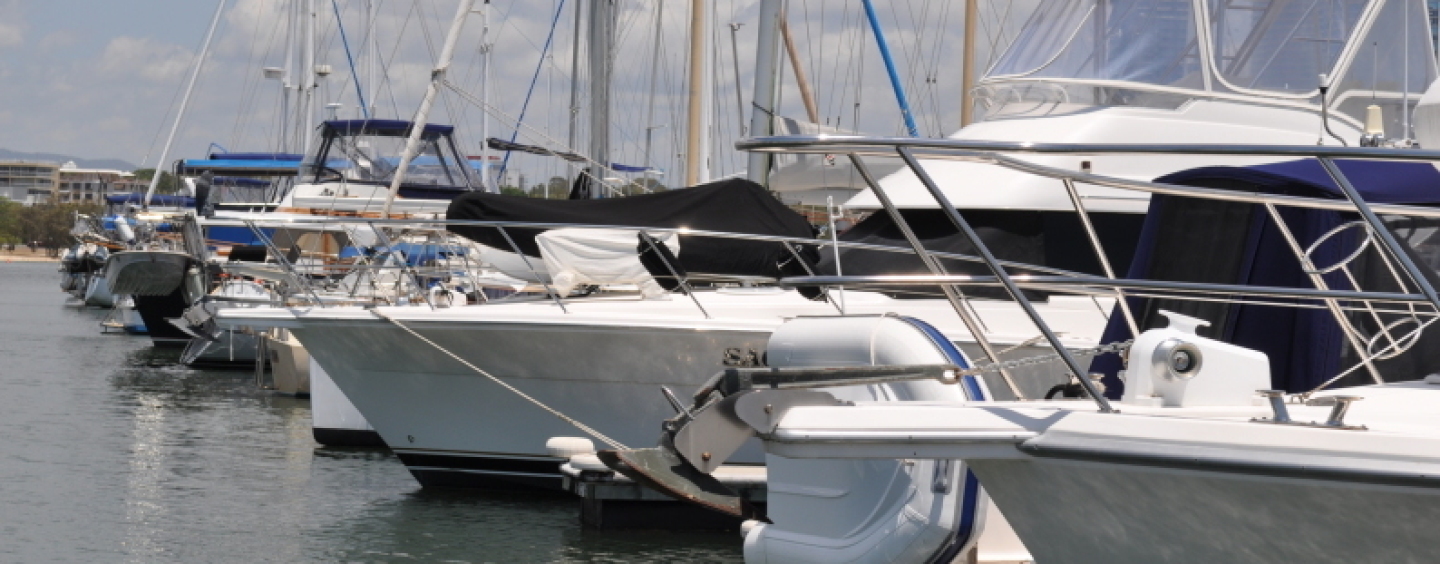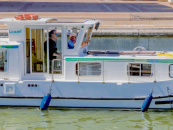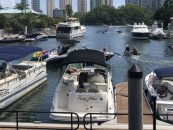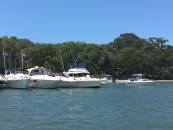In early 2016, the Marina Industries Association of Australia (MIA) released the Club Marine 2015 Health of the Australian Marina Industry Survey (2015 Marina Industry Survey). In a statement released by MIA, the marina industry proves to be very healthy. “The survey findings reveal that Australian marinas are financially healthy and over half of the marinas expect revenues to grow in the 2015-2016 FY. The majority of marinas continue to undertake various measures to enhance their facilities and the quality of the service(s) offered. The findings also strongly suggest that there continues to be ‘demand’ for marinas to add storage spaces and customer services.”
Marina 101
A marina has been defined as a specially designed harbour with moorings for pleasure yachts and small boats, 50 metres or less. (Oxford) It has also been defined as “a group of pontoons, jetties, piers, or similar structures designed or adapted to provide berthing for craft used primarily for pleasure or recreation and may include ancillary works such as slipways, facilities for the repair and maintenance of boats and the provision of fuel, provisions and accessories” (AS 3962-2001).
Marinas may be located along the banks of rivers connecting to lakes or seas and may be inland. They are also located on coastal harbors (natural or man made) or coastal lagoons, either as stand-alone facilities or within a port complex.
A marina may have refueling, washing and repair facilities, marine and boat chandleries, retail shops and restaurants. It may include ground facilities such as parking lots for vehicles and boat trailers. It may provide in- or out-of-water boat storage.
Fee-based services such as parking, use of picnic areas, pubs and clubhouses are usually included in long-term rental agreements. Visiting boaties usually have the option of buying each amenity from a fixed schedule of fees. Arrangements can be as wide as a single use, such as a shower, or several weeks of temporary berthing. Since marinas are often limited by available space, it may take years on a waiting list to get a permanent berth.
Marinas may be owned and operated by a private club, especially yacht clubs—but also as private enterprises or municipal facilities. Marinas may be stand-alone private businesses, components of a resort, or owned and operated by public entities.
In Australia, there are currently 346 marinas nationwide. The design, manufacturing and operation standard that the marina industry follow is the AS 3962-2001. It sets out guidelines for the design of marinas suitable for vessels up to 50m in length, and covers fixed berth and floating pontoon marina systems, single pontoons and floating wave attenuators. Guidance is also provided for on-shore facilities such as dry boat storage, boatlifts, boat ramps and associated parking facilities.
Marinas not only benefit the boaties and the marine industry in general, but they also have a very significant social and economic value to the community in the locality they are in.
According to the 2015 Marina Industry Survey, Australian marinas create employment for over 23,000 people. Job creation is steadily increasing in this sector and the industry is optimistic on this aspect. Marinas that offer direct boat services comprise businesses that employ staff to deliver required skills and expertise.
The immediate community also benefits from having marinas. Marinas produce an aesthetic amenity to the locality by creating ambiance and scenery that only a boat harbour can provide. Tourism is promoted in the area, as these marinas are destinations by themselves. Some marinas offer land-based accommodation, retail and restaurant options, and thus give the non-boaties the opportunity to enjoy the destination.
The role of marinas in environmental protection is also a growing responsibility.
ISO 14001:2015 is the International Standard that specifies the requirements for an environmental management system that an organisation can use to enhance its environmental performance, and is the guideline used in the marina industry. Using best practices, marinas have a huge role in enhancing the environment on which they are located through constant monitoring of water quality and educating marina visitors about the local aquatic habitat.
The industry in perspective
The MIA is the peak representative body for marinas, slipways, boatyards, berthing, mooring and other marine storage facilities, as well as sailing and cruising yacht clubs, in Australia. Its membership comprises more than 85% of the major Australian marinas, including a number of members from overseas.
Its role is “to contribute to the sustainable development of the industry and its members through the promotion of marinas and the provision of education, accreditation and research programs and policies.” It has developed the Clean Marinas and the Fish-Friendly Marinas programs that entail environmental accreditation for its members.
Although it has a big role in terms of the development and progress of the industry, the MIA is not a regulatory body. However, it aims to keep its members ahead of government regulations through continually lifting the level of professionalism in the industry.
Technology is also a big factor in the management of marinas. According to Colin Bransgrove, executive officer of the MIA, “Each marina is unique so their needs for technology and innovation can differ. However, like most businesses, the use of computer software is required by marinas to be more productive in areas such as managing boat storage and communication with customers. From an innovation perspective, marinas are adopting energy-saving technologies related to power and water savings. As regulations make boat repairs and maintenance more difficult, more marinas are innovating with new income streams through providing leisure and recreational services and facilities, such a kayak hire and kayak storage, boat hire and boat share, and by expanding food and dining options.”
While the 2015 Survey showed a strong marina industry, there are still challenges that face the marinas. Colin expounds, “Marinas have many of the same challenges as any business such as taxes, labour costs and red tape. However, the waterside location of marinas creates specific issues such as lease arrangements, and in many instances, a lack of long-term security of tenure that can be an issue for banks. Some government landlords do not fully appreciate the public amenity many marinas deliver (fuel services, dining and function facilities etc.) and they do not factor these community benefits into the equation for marina lease charges. We also have marinas that have for over a decade been wading through planning and development processes. This is a serious barrier to any upgrading of marina infrastructure.”
By their very nature, marinas often face the problems caused by salt water. “Marina maintenance due to the salt-water interface is a significant and on-going cost for marinas. Long-term planning and budgeting is needed to keep on top of the wear and tear, particularly around the on-water pontoon infrastructure,” continues Colin.
While the value of marinas as an amenity to the community is recognised, there is still the need for continuing education about the benefits of marinas. Colin further explains, “Reputable marina research is important to demonstrate the benefits of marinas to government and communities. And this is why MIA’s research program is very important.”
Gold Coast marinas
There are about 20 marinas, slipways and boatyards within the jurisdiction of the City of Gold Coast. There is only one marina owned by a yacht club (Southport Yacht Club), while the rest are privately owned businesses. Several boatyards and slipways offer comprehensive services, and some even have dining options. Many are also attached to lifestyle establishments that offer boaties and the public shopping, dining and other leisure activities.
The Gold Coast is a unique and globally competitive marine destination and industry hub. Colin identifies three matters of priority for the city. “Ensuring the city’s competitive advantage is firstly recognised by governments and the community is an on-going priority for the industry. Secondly, to build on this opportunity with suitable planning and investment is very important. Thirdly, the industry can continue to be a growing source of employment and economic growth for the Gold Coast if the opportunity is fully understood and a long term strategic approach is taken to encourage sustainable industry development.”
Managers of some Gold Coast marinas have also expressed concerns for ensuring sustainability through the promotion of tourism and keeping waterways clean and safe. “It is essential to support our government authorities on dredging initiatives for our waterways as it is essential to maintain safe and deep navigational channels, and on promoting the Gold Coast as a boating destination,” says Helen Motteram, marine operations manager of Mulpha Sanctuary Cove Marina.
Mark Riddell, waterfront manager of Southport Yacht Club, affirms the need for dredging. “We need more dredging for the channels, so we can get the bigger boats in.” Paul Sorrel, general manager of Horizon Shores Marina, further confirms, “Dredging waterways enable crafts to navigate safely.” Steve Sammes, chief operating officer of the Gold Coast City Marina, also adds, “More berthage is needed to accommodate the demands of superyachts.”
“Protecting our environment is our priority, and every effort is made to protect our ecosystems,” asserts Gary Klein, marina manager of Boat Masters Hope Harbour. “Regulations governing the marina sector are very strict, covering everything from waste water runoff to air pollution. However, we still rely on the boating public to safely dispose of their waste with due consideration for our sensitive environment.”
The diversity that the City offers to various sectors adds to the value of the Gold Coast as a unique destination, and the marinas are no exceptions. Paul and Steve best state the uniqueness of the Gold Coast marinas. Paul says, “The Gold Coast as we all know is a unique combination of open seas, protected waterways and numerous canals. Because of this, each marina is different and caters for different boats and price points—from the Coomera Marine Precinct, which is halfway down the bends and winds of the Coomera River, to the open waters of the Broadwater. It’s hard to find another on-water location that can match the vast choice that the Gold Coast offers to boating enthusiasts and charter operators,” while Steve sums up, “The Gold Coast marinas are unique because of their location, the services afforded and the variety of destinations right on the door step to choose from. The proximity to two major airports, tourism attractions, theme parks and our unique hinterland contribute to the uniqueness of the Gold Coast.”
By Roselle Tenefrancia
Marinas are important assets to a community. Everyone who uses or visits marinas should observe proper behavior. Here are helpful tips given by the marina managers on the Gold Coast:
- Use the on-shore facilities as much as possible (toilets, showers, etc.)
- Keep your vessel well maintained at all times.
- Make sure you keep to the speed limit with no wash. Look behind you, and always check for your wash.
- Do not pump out your tanks inside the marinas.
- Keep your areas tidy to avoid hazards to others.
- When coming in, brief your crew and/or have your lines and fenders ready.
- Utilise re-usable bags for shopping and other needs.
- Be nice to your neighbours. Be considerate of your fellow boaties at all times.
- Respect your environment.
- Educate yourself. (Australian Boating College conducts free education nights at Horizon Shores.)
(RT)
List of Gold Coast marinas
Bayview Harbour Yacht Squadron
Boat Masters Hope Harbour
Calypso Bay Marina
Coomera Waters Marina
Couran Cove Island Resort
Ephraim Island Marina
Gold Coast City Marina
Hope Harbour Marina
Hope Island Marina
Horizon Shores Marina
Marina Mirage
Mariner’s Cove Marina
Mulpha Sanctuary Cove Marina
Palazzo Versace Marina
Riviera Marina
Runaway Bay Marina
Salacia Waters Marina
Southport Yacht Club
Sovereign Island Marina
The Boat Works
*Not all marinas offer public berthing. Contact the marina offices directly for more information on berthing and other services.



























